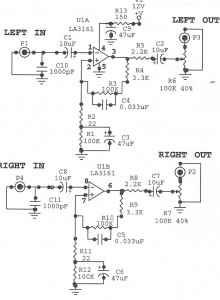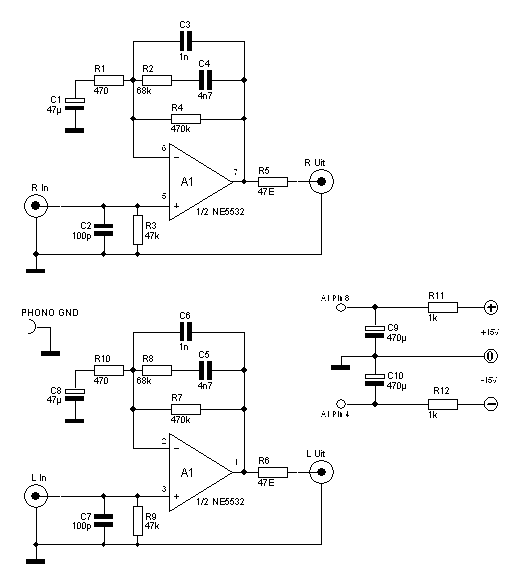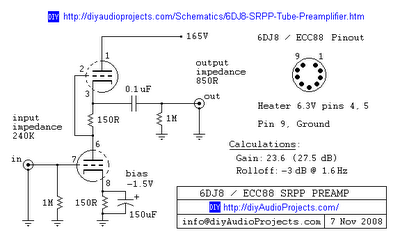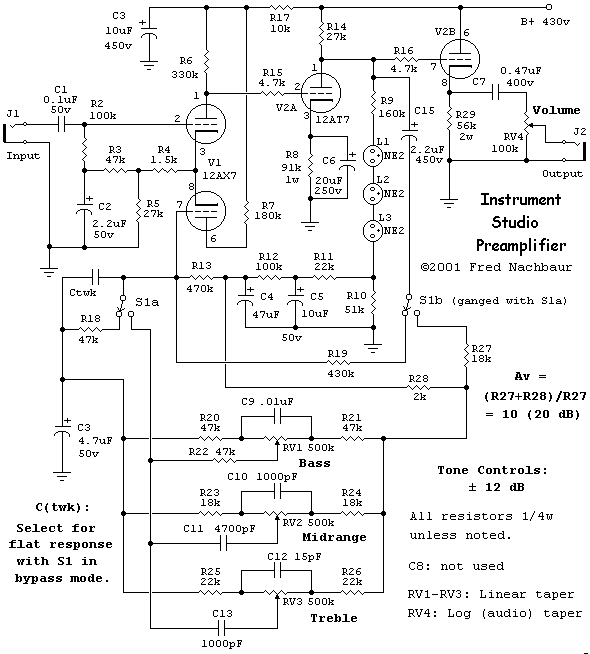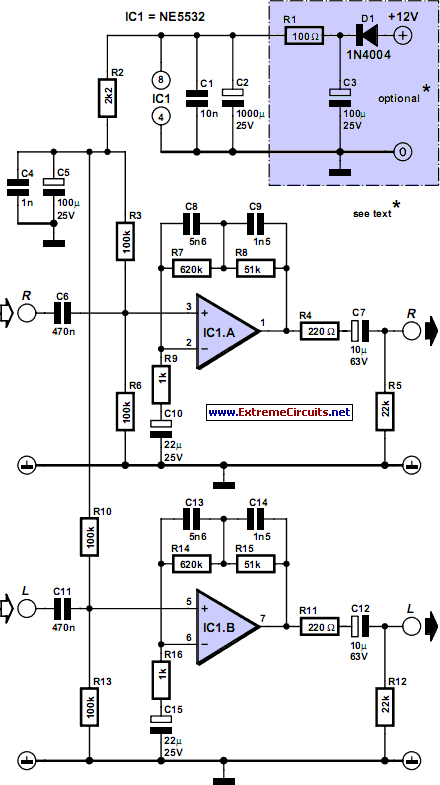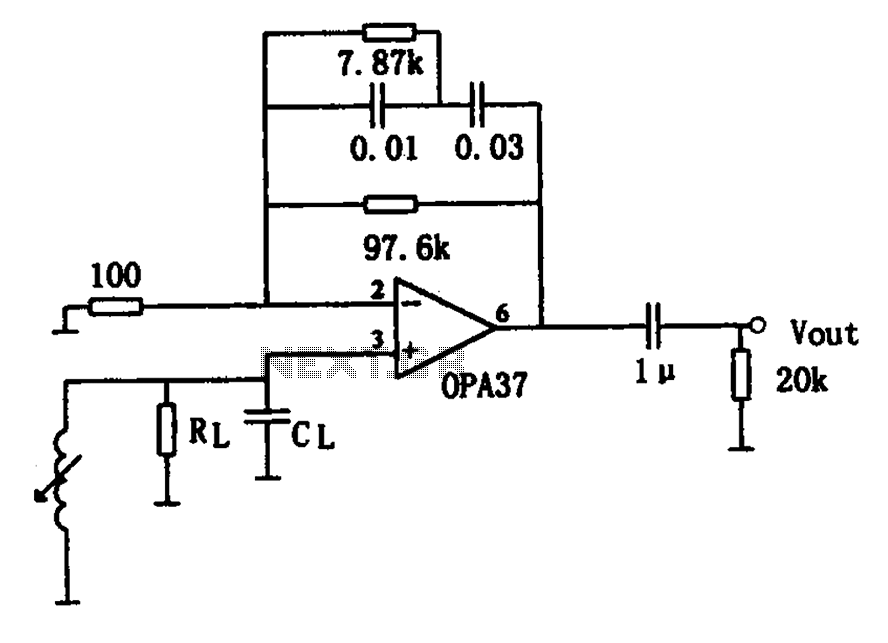
vox ac30 preamp
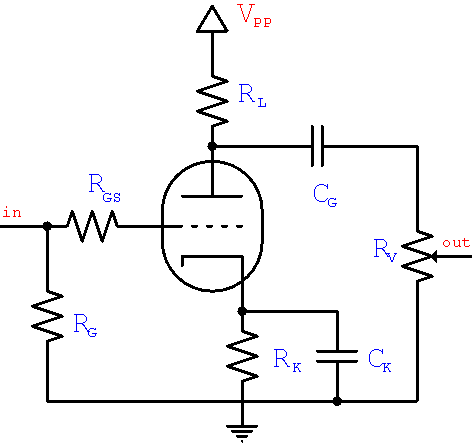
The bright channel of the Vox AC30 Top Boost preamp begins with a traditional 12AX7 preamp connected to a volume control with a bright bypass capacitor. This is followed by two more stages to prepare the signal for the tone stack. The normal channel starts with the same preamp but without a bypass capacitor, and its output is connected directly to the phase inverter. The low-gain input jacks for both channels are connected to an inverted-L network that acts as a voltage divider to attenuate the input signal by half, or 3dB. The resistance Ro is the output impedance of the guitar and represents the ability of the guitar circuit to drive the amplifier input. An output impedance of zero ohms signifies that the guitar is a pure voltage source that can supply any amount of current to the next stage. A non-zero output impedance represents the decrease in voltage magnitude that occurs depending on how much current is required. The other parts values are (RGS represents the effective value of two 68k resistors in parallel). The gamma network exploits the capacitance between the tube's electrodes to attenuate radio frequencies, as demonstrated by our Grid Stopper Resistor Calculator (when we use in advance a voltage gain of 74 that we will determine shortly). The calculator shows 11dB attenuation at 128kHz but less than 1dB cut at 16kHz. For good treble response, this is quite sufficient for a guitar amp. The bright channel adds a bypass capacitor to the volume control, which will be discussed in a moment. At DC, all the capacitors are open circuits, so the bright and normal channels have identical DC operating points. Under DC conditions, the cathode resistor RK carries the current of two triodes, so its effective resistance per triode is 3k, double its nominal value of 1.5k. For a plate supply voltage of VPP = 275 and a plate load resistor of RL = 220k, the load line (red) and grid lines (blue) for RK = 3k are plotted here: The lines intersect at a DC grid bias voltage of minus 1.8 volts. The DC operating point for the bright and normal triodes is thus defined by a quiescent grid voltage, plate voltage, and plate current. When two triode amplifiers share the same cathode resistor, it is important to ensure that RK is fully bypassed by CK. Otherwise, the two triodes become a common-cathode differential amplifier instead of independent amplifiers. The 25uF capacitor used by Vox effectively shorts all audio frequencies to ground, thus completely bypassing the resistor and providing maximum gain. This is demonstrated by our Cathode Bypass Capacitor Calculator. For RG, 1M is used, as it refers to the grid resistor of the following stage, representing the load that the preamp is required to drive. In the case of the AC30 preamp, this is the volume control RV. The calculator shows that the voltage gain is 74 for all audio frequencies. The output impedance of the first stage, which represents its ability to drive a load, depends on the plate load resistor value RL and whether the cathode resistor RK is fully bypassed. The Preamp Output Impedance Calculator shows that the first stage has an output impedance of 49k. This compares to only 38k for a preamp with a 100k plate resistor. By using a higher resistor value than in a typical Fender or Marshall, the AC30 has greater voltage gain and a higher output impedance. The calculator shows an unloaded gain of 78, representing the voltage gain that is achieved if the preamp is disconnected from the volume control. It also shows an output impedance of 49k, which causes the voltage gain to sag to 74 when connected to the next stage. This is not much attenuation, because the 1M volume control does not demand much current. If the load were an electron-hungry tonestack, then the situation would be quite different. The coupling capacitor CG blocks the high DC voltage at the plate but is designed to be large enough to pass all audio frequencies.
The Vox AC30 Top Boost preamp circuit is a classic design that emphasizes both tonal richness and versatility. The architecture begins with a 12AX7 vacuum tube, which is a dual triode commonly used for its high gain characteristics. The bright channel's configuration includes a volume control that employs a bypass capacitor, enhancing high-frequency response and allowing for a brighter tone. The signal then progresses through additional amplification stages, ultimately leading to the tone stack, which shapes the overall tonal output before reaching the phase inverter.
The normal channel mirrors the bright channel's initial stage but omits the bypass capacitor, resulting in a slightly warmer tone that is more subdued in treble frequencies. The input stage utilizes an inverted-L network to manage the input signal, effectively halving its amplitude and ensuring compatibility with the amplifier's input requirements. The output impedance, denoted as Ro, plays a crucial role in determining how well the guitar can drive the amplifier's input. A zero-ohm output impedance indicates that the guitar can deliver an infinite current, while a non-zero value reflects the voltage drop that occurs under load conditions.
The circuit further incorporates a gamma network designed to filter out unwanted radio frequencies, leveraging the inherent capacitance between the tube's electrodes. This feature is critical in maintaining signal integrity, particularly at higher frequencies, where the network demonstrates effective attenuation characteristics.
Capacitors within the circuit are integral to defining the DC operating point. The shared cathode resistor RK, which serves two triodes, effectively doubles its resistance when accounting for the shared current. This configuration ensures that both channels maintain consistent operating conditions under DC bias, crucial for stable performance. The use of a 25uF bypass capacitor allows for efficient signal amplification by shorting audio frequencies to ground, thus maximizing gain without introducing distortion.
The subsequent stage's grid resistor RG, set at 1M, influences the load seen by the preamp. This value is optimized for the AC30's design, facilitating a voltage gain of 74 across the audio spectrum. The resulting output impedance of 49k is indicative of the preamp's capability to drive subsequent stages effectively. The design philosophy behind the AC30 emphasizes higher plate resistor values compared to other amplifiers, yielding increased voltage gain and output impedance.
In conclusion, the Vox AC30 preamp circuit exemplifies a well-engineered design that balances gain, tone shaping, and signal integrity. The interplay between its components, including the bypass capacitors, resistors, and coupling capacitors, creates a versatile platform for achieving a wide range of tonal characteristics, making it a favored choice among guitarists seeking rich and dynamic sound.The bright channel of the Vox AC30 Top Boost preamp begins with a traditional 12AX7 preamp connected to a volume control with a bright bypass capacitor. This is followed by two more stages to prepare the signal for the tone stack. The normal channel starts with the same preamp but without a bypass capacitor and its output is connected directly to
the phase inverter. The low-gain input jacks for both channels are connected to an inverted-L network that acts as a voltage divider to attenuate the input signal by half, or 3dB. The resistance Ro is the output impedance of the guitar and represents the ability of the guitar circuit to drive the amplifier input.
An output impedance of zero ohms signifies that the guitar is a pure voltage source that can supply any amount of current to the next stage. A non-zero output impedance represents the decrease in voltage magnitude that occurs depending on how much current is required.
The other parts values are (RGS represents the effective value of two 68k resistors in parallel. ) The gamma network exploits the capacitance between the tube`s electrodes to attenuate radio frequencies, as demonstrated by our Grid Stopper Resistor Calculator (when we use in advance a voltage gain of 74 that we will determine shortly). The calculator shows 11dB attenuation at 128kHz but less than than 1dB cut at 16kHz. For good treble response this is quite sufficient for a guitar amp. The bright channel adds a bypass capacitor to the volume control, which we will discuss in a moment. At DC all the capacitors are open circuits, so the bright and normal channels have identical DC operating points.
Under DC conditions the cathode resistor RK carries the current of two triodes, so its effective resistance per triode is 3k, double its nominal value of 1. 5k. For a plate supply voltage of VPP = 275 and a plate load resistor of RL = 220k the load line (red) and grid lines (blue) for RK = 3k are plotted here: The lines intersect at a DC grid bias voltage of minus 1.
8 volts. The DC operating point for the bright and normal triodes is thus defined by a quiescent grid voltage, plate voltage, and plate current of When two triode amplifiers share the same cathode resistor we want to ensure that RK is fully bypassed by CK. Otherwise the two triodes become a common-cathode differential amplifier instead of independent amplifiers.
The 25uF capacitor used by Vox effectively shorts all audio frequencies to ground, thus completely bypassing the resistor and providing maximum gain. This is demonstrated by our Cathode Bypass Capacitor Calculator. For RG we use 1M, because it refers to the grid resistor of the following stage, representing the load that the preamp is required to drive.
In the case of the AC30 preamp this is the volume control RV. The calculator shows that the voltage gain is 74 for for all audio frequencies. The output impedance of the first stage, which represents its ability to drive a load, depends on the plate load resistor value RL and whether the cathode resistor RK is fully bypassed. Our Preamp Output Impedance Calculator shows that the first stage has an output impedance of 49k. This compares to only 38k for a preamp with a 100k plate resistor. By using a higher resistor value than in a typical Fender or Marshal, the AC30 has greater voltage gain and a higher output impedance.
The calculator shows an unloaded gain of 78, representing the voltage gain that is achieved if the preamp is disconnected from the volume control. It also shows an output impedance of 49k, which causes the voltage gain to sag to 74 when connected to the next stage.
This is not much attenuation, because the 1M volume control doesn`t demand much current. If the load were an electron-hungry tonestack then the situation would be quite different. The coupling capacitor CG blocks the high DC voltage at the plate but is designed to be large enough to pass all audio frequencies o 🔗 External reference
The Vox AC30 Top Boost preamp circuit is a classic design that emphasizes both tonal richness and versatility. The architecture begins with a 12AX7 vacuum tube, which is a dual triode commonly used for its high gain characteristics. The bright channel's configuration includes a volume control that employs a bypass capacitor, enhancing high-frequency response and allowing for a brighter tone. The signal then progresses through additional amplification stages, ultimately leading to the tone stack, which shapes the overall tonal output before reaching the phase inverter.
The normal channel mirrors the bright channel's initial stage but omits the bypass capacitor, resulting in a slightly warmer tone that is more subdued in treble frequencies. The input stage utilizes an inverted-L network to manage the input signal, effectively halving its amplitude and ensuring compatibility with the amplifier's input requirements. The output impedance, denoted as Ro, plays a crucial role in determining how well the guitar can drive the amplifier's input. A zero-ohm output impedance indicates that the guitar can deliver an infinite current, while a non-zero value reflects the voltage drop that occurs under load conditions.
The circuit further incorporates a gamma network designed to filter out unwanted radio frequencies, leveraging the inherent capacitance between the tube's electrodes. This feature is critical in maintaining signal integrity, particularly at higher frequencies, where the network demonstrates effective attenuation characteristics.
Capacitors within the circuit are integral to defining the DC operating point. The shared cathode resistor RK, which serves two triodes, effectively doubles its resistance when accounting for the shared current. This configuration ensures that both channels maintain consistent operating conditions under DC bias, crucial for stable performance. The use of a 25uF bypass capacitor allows for efficient signal amplification by shorting audio frequencies to ground, thus maximizing gain without introducing distortion.
The subsequent stage's grid resistor RG, set at 1M, influences the load seen by the preamp. This value is optimized for the AC30's design, facilitating a voltage gain of 74 across the audio spectrum. The resulting output impedance of 49k is indicative of the preamp's capability to drive subsequent stages effectively. The design philosophy behind the AC30 emphasizes higher plate resistor values compared to other amplifiers, yielding increased voltage gain and output impedance.
In conclusion, the Vox AC30 preamp circuit exemplifies a well-engineered design that balances gain, tone shaping, and signal integrity. The interplay between its components, including the bypass capacitors, resistors, and coupling capacitors, creates a versatile platform for achieving a wide range of tonal characteristics, making it a favored choice among guitarists seeking rich and dynamic sound.The bright channel of the Vox AC30 Top Boost preamp begins with a traditional 12AX7 preamp connected to a volume control with a bright bypass capacitor. This is followed by two more stages to prepare the signal for the tone stack. The normal channel starts with the same preamp but without a bypass capacitor and its output is connected directly to
the phase inverter. The low-gain input jacks for both channels are connected to an inverted-L network that acts as a voltage divider to attenuate the input signal by half, or 3dB. The resistance Ro is the output impedance of the guitar and represents the ability of the guitar circuit to drive the amplifier input.
An output impedance of zero ohms signifies that the guitar is a pure voltage source that can supply any amount of current to the next stage. A non-zero output impedance represents the decrease in voltage magnitude that occurs depending on how much current is required.
The other parts values are (RGS represents the effective value of two 68k resistors in parallel. ) The gamma network exploits the capacitance between the tube`s electrodes to attenuate radio frequencies, as demonstrated by our Grid Stopper Resistor Calculator (when we use in advance a voltage gain of 74 that we will determine shortly). The calculator shows 11dB attenuation at 128kHz but less than than 1dB cut at 16kHz. For good treble response this is quite sufficient for a guitar amp. The bright channel adds a bypass capacitor to the volume control, which we will discuss in a moment. At DC all the capacitors are open circuits, so the bright and normal channels have identical DC operating points.
Under DC conditions the cathode resistor RK carries the current of two triodes, so its effective resistance per triode is 3k, double its nominal value of 1. 5k. For a plate supply voltage of VPP = 275 and a plate load resistor of RL = 220k the load line (red) and grid lines (blue) for RK = 3k are plotted here: The lines intersect at a DC grid bias voltage of minus 1.
8 volts. The DC operating point for the bright and normal triodes is thus defined by a quiescent grid voltage, plate voltage, and plate current of When two triode amplifiers share the same cathode resistor we want to ensure that RK is fully bypassed by CK. Otherwise the two triodes become a common-cathode differential amplifier instead of independent amplifiers.
The 25uF capacitor used by Vox effectively shorts all audio frequencies to ground, thus completely bypassing the resistor and providing maximum gain. This is demonstrated by our Cathode Bypass Capacitor Calculator. For RG we use 1M, because it refers to the grid resistor of the following stage, representing the load that the preamp is required to drive.
In the case of the AC30 preamp this is the volume control RV. The calculator shows that the voltage gain is 74 for for all audio frequencies. The output impedance of the first stage, which represents its ability to drive a load, depends on the plate load resistor value RL and whether the cathode resistor RK is fully bypassed. Our Preamp Output Impedance Calculator shows that the first stage has an output impedance of 49k. This compares to only 38k for a preamp with a 100k plate resistor. By using a higher resistor value than in a typical Fender or Marshal, the AC30 has greater voltage gain and a higher output impedance.
The calculator shows an unloaded gain of 78, representing the voltage gain that is achieved if the preamp is disconnected from the volume control. It also shows an output impedance of 49k, which causes the voltage gain to sag to 74 when connected to the next stage.
This is not much attenuation, because the 1M volume control doesn`t demand much current. If the load were an electron-hungry tonestack then the situation would be quite different. The coupling capacitor CG blocks the high DC voltage at the plate but is designed to be large enough to pass all audio frequencies o 🔗 External reference
